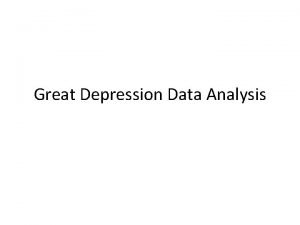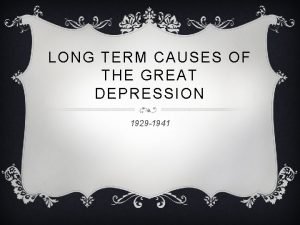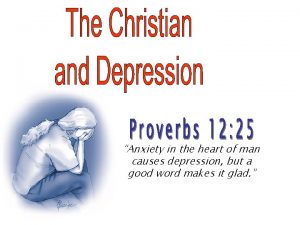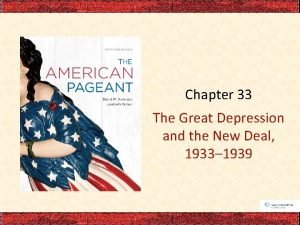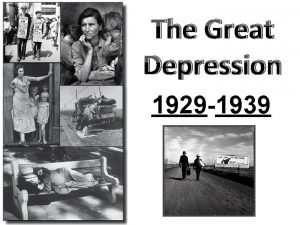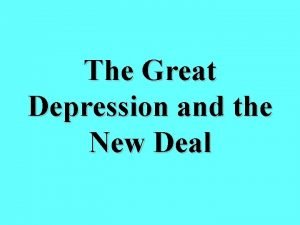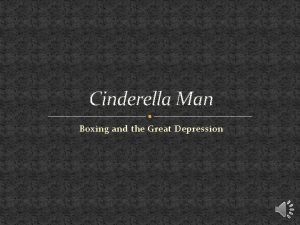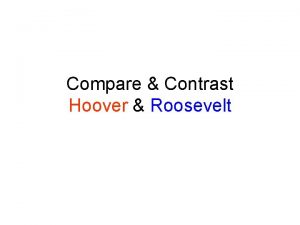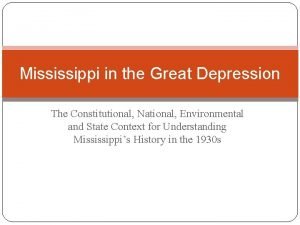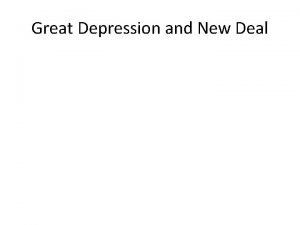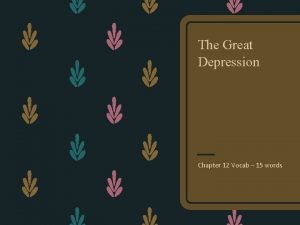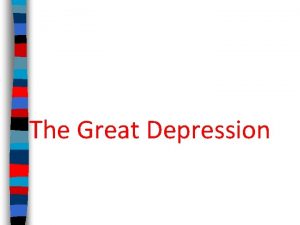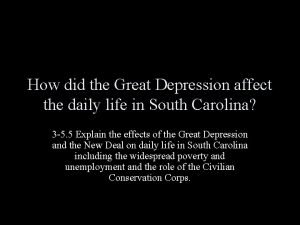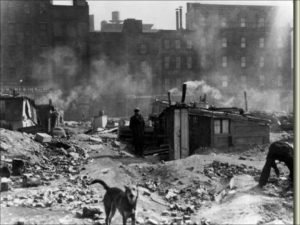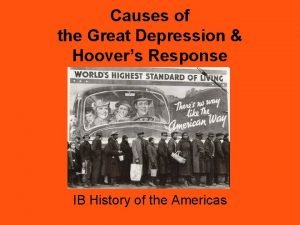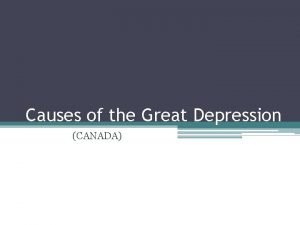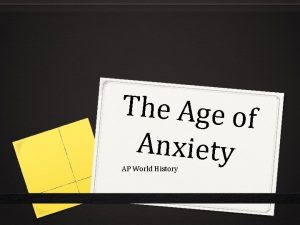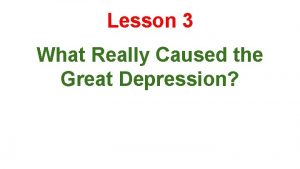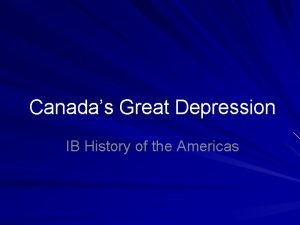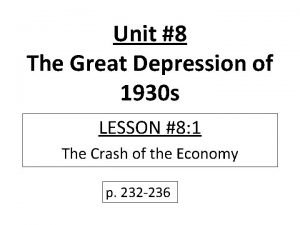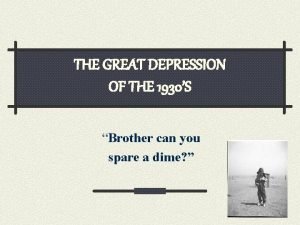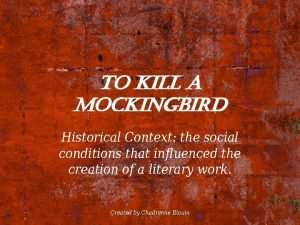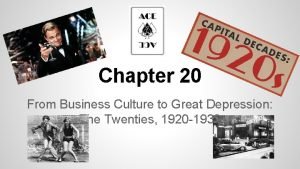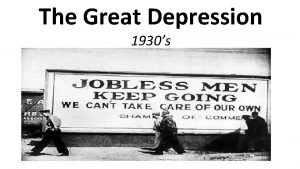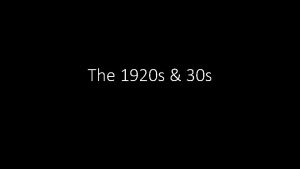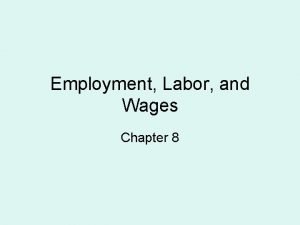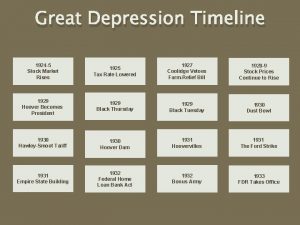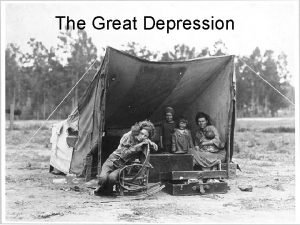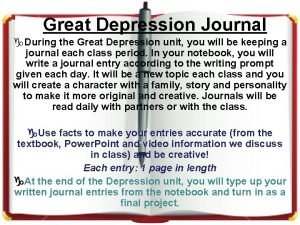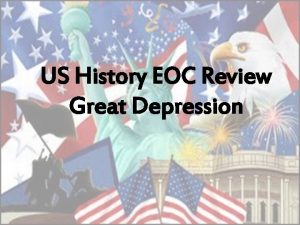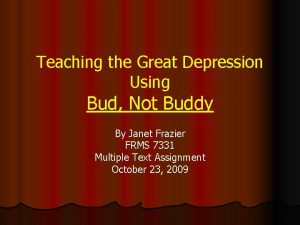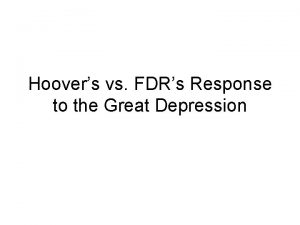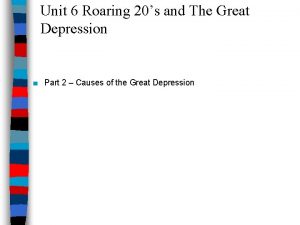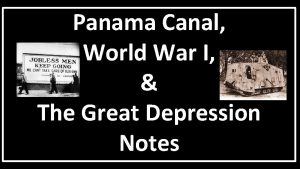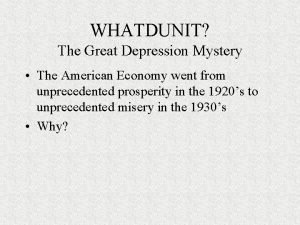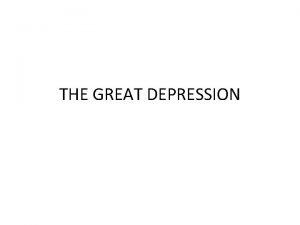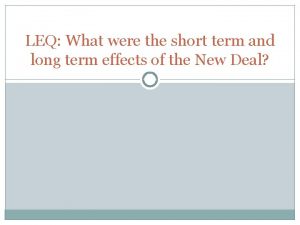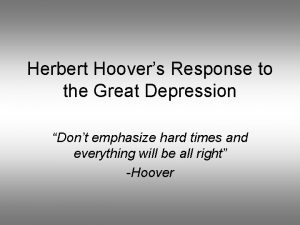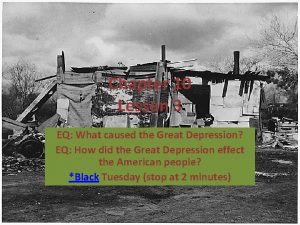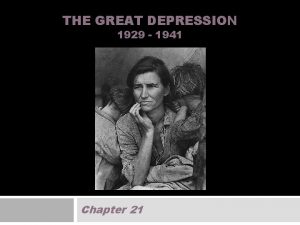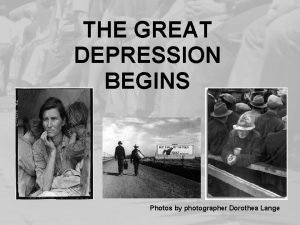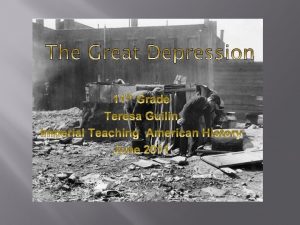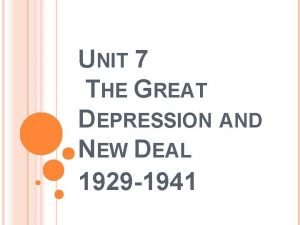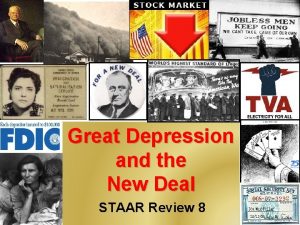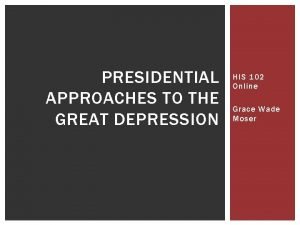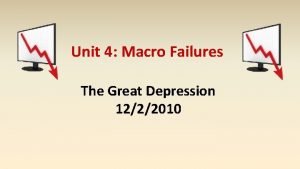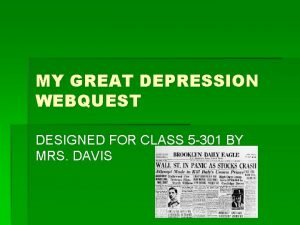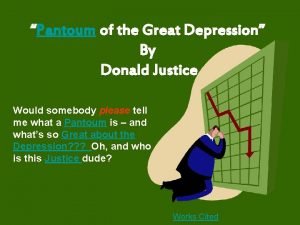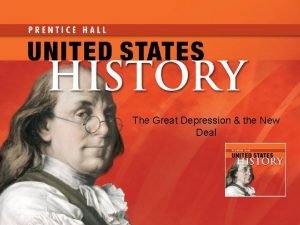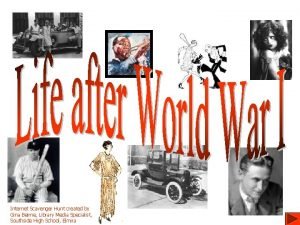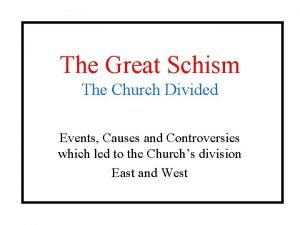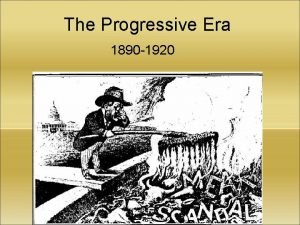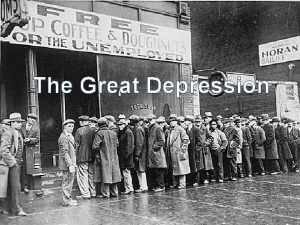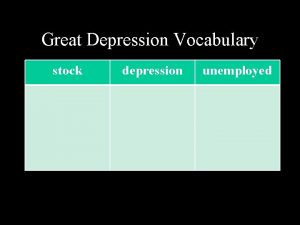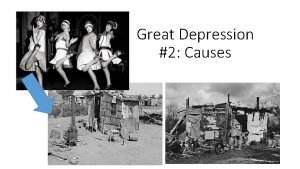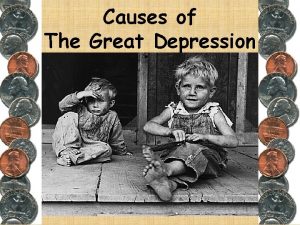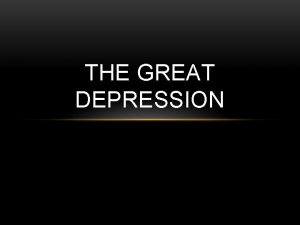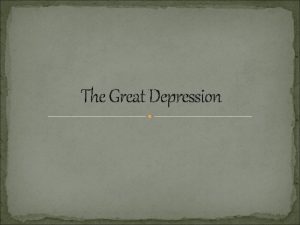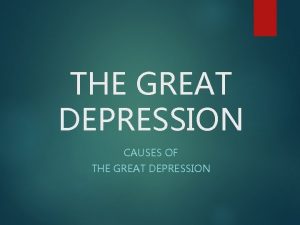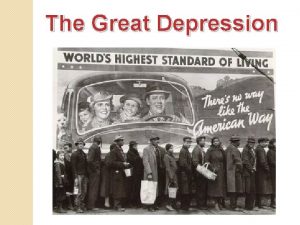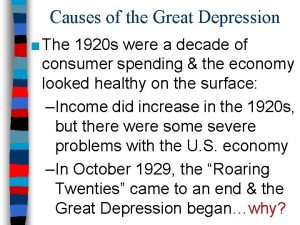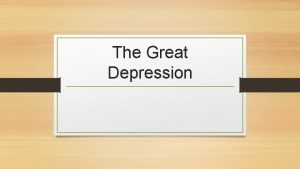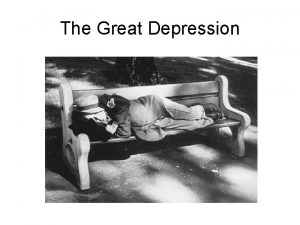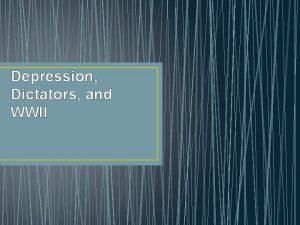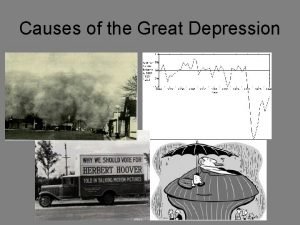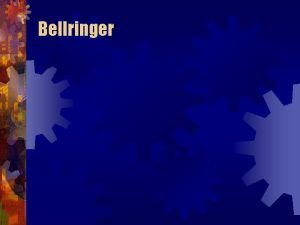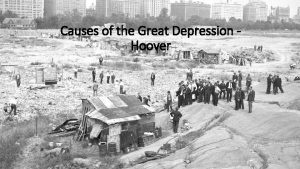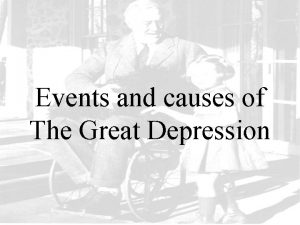Causes of the Great Depression The 1920 s













































































- Slides: 77

Causes of the Great Depression ■ The 1920 s were a decade of consumer spending & the economy looked healthy on the surface: –Income did increase in the 1920 s, but there were some severe problems with the U. S. economy –In October 1929, the “Roaring Twenties” came to an end & the Great Depression began…why?

Causes of the Depression ■ Weak Industries: – Mass-production of consumer goods led to “Traditional industries” faced new overproduction competition in the 1920: Cars, synthetic natural – Peopleclothes, did not needgas as many appliances & cars by the end of the decade (under-consumption) – Railroads, textiles, steel, coal mining, construction were barely profitable

Overproduction of Consumer Goods Too much inventory…Not enough buyers

“Traditional” industries suffered in the 1920 s Corporate Profits for Coal and Railroad Industries, 1920 -1930 Profits for Railroad Companies Profits for Coal Mining

Causes of the Depression ■ Depressed Farming: – The end of WWI led to a decline in demand for agricultural products – Too much food led to a 40% drop in crop prices – Farmers could not pay back loans & many had their farms foreclosed – Some rural banks failed

Causes of the Depression ■ Credit: – Many Americans used easy credit to live beyond their means – By “buying now & paying later, ” Americans generated large debts – As a result, Americans cut back on spending by the end of the decade

Americans bought goods on credit & did not have much in savings accounts

Causes of the Depression ■ Uneven Division of Wealth – Despite rising wages, the gap between the rich & poor grew wider in the 1920 s – 70% of Americans were considered “poor” – Most of the spending in the 1920 s was done by 30% of the population

Distribution of Wealth in the 1920 s * An income of $2, 500 per year was considered the minimum amount needed for a decent standard of living

Causes of the Depression ■ The Stock Market: – In the 1920 s, the stock market soared & people speculated with stocks – Many people borrowed money to pay for stocks, called buying on margin – There was no regulation of the market & some companies altered stock values to raise profits

Buying Stocks on Margin

The stock market Causes of the Depression crash in October ■ The Stock Market: 1929 marked the beginning of the – On October 29, 1929 (Black Tuesday) the “Great Depression” stock market crashed – People rushed to sell, prices plummeted, & investors lost $30 billion – Speculators who bought on the margin, could not pay off their debts – Many lost their savings

The U. S. stock market had only about 3 million active buyers & sellers but the spillover into the greater economy led to the Great Depression

Causes of the Depression ■ Bank Failures: – After the crash, people tried to withdraw their money from banks – In 1929, 600 banks failed due to lack of funds & the inability to recoup loans – The failure of the banks left many Americans without their life savings

Bank & Business Failures, 1928 -1933

Causes of the Depression ■ Foreign Trade: – Post-war debts in Europe & high protective tariffs in America limited international trade – The Great Depression led to a global depression in Europe, Asia, & Latin America – World trade fell by 40%

A Global Depression

Causes of the Depression ■ Consumer Confidence: – Millions of Americans lost their jobs or took pay cuts to keep jobs – The lack of confidence in the future kept people from spending money – The lack of spending made the depression drag on until the 1940 s

Unemployment & Consumer Spending, 1928 -1933

Effects of the Great Depression ■ The Great Depression led to a collapse of the U. S. financial system – 25, 000 banks & 90, 000 businesses failed by 1933 –Unemployment peaked at 25% –Many Americans lost their homes –America had record poverty & suicide rates; Fathers abandoned families; Healthcare declined –Private charities created soup kitchens & breadlines to help

Soup Kitchens & Breadlines Rudy Vallee “Brother Can You Spare a Dime? ” Some plays for next 4 slides

Mortgage Foreclosures


The Dust Bowl ■ The effects of the depression were made worse by the Dust Bowl: –Heavy droughts & over-farming in the West destroyed the Plains –In the early 1930 s, windstorms swept away loose soil –Farmers in the Plains left their farms & searched for work or better land in West coast states

The Dust Bowl (1931 -1939) Areas Affected by the Dust Bowl drought “Okies” & “Arkies” worsened the effects of the Depression

President Hoover’s Response ■ President Herbert Hoover initially rejected bold gov’t action in response to the depression: –He tried to reassure Americans that prosperity would return –He called for volunteerism & “rugged individualism”— Americans need to work together to end the depression

President Hoover’s Response ■ As the depression worsened, Hoover called for more gov’t action –The gov’t issued relief checks to help the unemployed –The Reconstruction Finance Corps (RFC) loaned money to failing businesses –Building projects like Hoover Dam ■ These efforts did not end the depression & many citizens lost faith in President Hoover


Employment Agencies & Relief-Check Lines

Americans who lost their homes, lived in shantytowns nicknamed “Hoovervilles”


Conclusions ■ The Depression of the 1930 s came as a shock to Americans: –When the stock market crashed in 1929, businesses closed & millions were unemployed –Americans lost faith in Hoover & began looking for new leadership & a more active gov’t to solve their problems

Hoover & the Depression ■ From 1929 to 1932, President Hoover was criticized for not doing more to end the depression –Unemployment reached 25% –U. S. banking collapsed –Hoover offered gov’t intervention (relief check, job programs) but it was seen as too little, too late ■ By the election of 1932, Americans wanted hope & strong leadership

Unemployment in America, 1929 -1942

FDR & the New Deal ■ In 1932, Democrat Franklin Roosevelt (FDR) defeated Hoover

“Let me assert my firm belief that the only thing we have to fear is fear itself; nameless, unreasoning, unjustified terror which paralyzes needed efforts to convert retreat into advance. ” FDR’s inaugural address in 1933 inspired hope

FDR & the New Deal ■ FDR initiated his New Deal, a series of laws that were designed to fight the depression by offering: –Relief: gov’t relief checks & jobs to get people back to work –Recovery: tried to end the depression by stimulating industry & farming –Reform: long-term solutions to America’s economic problems

The Hundred Days ■ In his 1 st 100 days in office, FDR & Congress passed 15 major laws –FDR’s 1 st action was to address the bank crisis; By 1933, people had no faith in banks –FDR declared a 4 -day bank holiday after which banks were allowed to re-open only after gaining a gov’t endorsement

Banks recovered & Americans slowly regained confidence in banks

FDR’s Fireside Chats Listen to the first few minutes of FDR’s ■ FDR usedchat the in radio to 1933 sell his New 1 st fireside March in which he explains to his the bank. American holiday people Deal programs –These “fireside chats” used simple , clear language to explain his New Deal programs & gain public support for these goals

New Deal: Relief ■ The greatest success of the New Deal was its ability to offer relief to unemployed citizens: –The gov’t provided relief checks to 15% of Americans –The gov’t created jobs for Americans

Percentage of American Families Accepting Government Relief in 1933

New Deal: Relief ■ Civilian Conservation Corps (CCC) was a work program for young men aged 18 -25: –The CCC built roads, soil erosion projects, & parks –The CCC employed 3 million young men

CCC workers paved roads, planted trees, built bridges

New Deal: Reforms ■ The New Deal created long-term reforms to address weaknesses in the American economy ■ Securities & Exchange Commission (SEC) was created to regulate the stock market & prevent another stock market crash

New Deal: Reforms ■ To help restore public confidence in banks, the Federal Deposit Insurance Corporation (FDIC) was created: –The national gov’t insures money in bank accounts (up to $250, 000 as of 2006)

New Deal: Reforms ■ The Tennessee Valley Authority (TVA) created hydroelectric power plants in the South –TVA created dams in 7 states to provide cheap hydroelectric power & create jobs


New Deal: Recovery ■ New Deal programs tried to stimulate the economy & end the depression –Agricultural Adjustment Act (AAA) tried to help farmers by paying them not to produce –By lowering supply, the gov’t hoped to increase crop prices


Unemployment in America, 1929 -1942 The New Deal began in 1933, but by 1935 the Great Depression had not yet come to an end

FDR’s Critics ■ The failure of the New Deal to end the depression led to frustration & criticism of FDR’s programs: –The most vocal critic was Louisiana Senator Huey Long –Long’s Share the Wealth plan suggested taxing all personal income over $1 million to give each family $2, 500 per year

Huey Long “The Kingfish” How many men ever …then we've got to went to a barbecue & Now, how are you But Mr. when they've got call Morgan & Mr. would let one man going to feed the everything on God's Mellon & Mr. take off the table balance of the loving earth that they Rockefeller back and what's intended for people? What's can eat & they can th say: “Come back here, 9/10 of the people Morgan & Baruch & wear & they can live put that stuff back on to eat? The only way Rockefeller & Mellon in, & all that their Huey Long threatened to run this table here that you'll ever be able to rd going to do with all children can live in as a 3 Party candidate but& you took away from feed the balance of that grub? They can't wear & eat, & all of was assassinated in 1935 here that you don't the is to make eat people it, they can't wear their children's need. Leave that man come back the clothes, they can't children can use, … something else for the & bring back some of live in the houses. American people to that grub that he ain't got noconsume. ” business with!

Court Packing ■ The Supreme Court declared 2 recovery programs unconstitutional –FDR feared that the Supreme Court would weaken the New Deal –FDR’s solution was called courtpacking: He wanted to increase the number of justices from 9 to 15 –Congress rejected his radical plan


FDR’s Second New Deal ■ In 1935, FDR launched the Second New Deal –The Works Progress Administration (WPA) was the biggest New Deal program –Created 10 million jobs in a variety of professions & cost the gov’t $10 billion

WPA Public Work Project

WPA Initiatives

WPA Arts Project

WPA Music Projects

WPA Theater Projects

FDR’s Second New Deal ■ Social Security was America’s 1 st welfare program; It created –Old-age pensions to be funded by employers & workers –Welfare payments for the blind, handicapped, & needy children

FDR’s Second New Deal ■ The Wagner Act: –Protected workers right to strike & collectively bargain –Outlawed unfair practices used by companies to discourage union membership

Conclusions ■ FDR’s New Deal created a new role for the U. S. government: –For the 1 st time, the gov’t used deficit spending (going into debt) to stimulate the economy –For the 1 st time, the gov’t took responsibility for the people & created welfare programs –New Deal successfully offered relief to ease peoples’ suffering, but it did not end the Depression

The Impact of FDR’s New Deal ■ Franklin Roosevelt’s New Deal programs had a significant impact on American history: Political Impact: FDR rejected conservative policies & began a new era of unprecedented gov’t activism to solve America’s problems

The Impact of FDR’s New Deal ■ Political Impact: –FDR gave citizens hope by using active gov’t programs, fireside chats, & decisive leadership –The New Deal was the 1 st attempt by the gov’t to take responsibility for the economy & welfare of the American people –FDR introduced deficit spending & welfare programs for the 1 st time

The New Deal and American Life ■ Political Impact: –FDR’s leadership unified a new voting coalition for the Democratic Party made up of unions, African Americans, immigrants, & poor voters

The Impact of FDR’s New Deal ■ Franklin Roosevelt’s New Deal programs had a significant impact on American history: Economic Impact: The New Deal helped relieve unemployment & provided long-term economic reforms, but it failed to end the Great Depression

The Impact of FDR’s New Deal ■ Economic Impact: –The New Deal relieved farmers (AAA), unions (Wagner Act), the unemployed (CCC, WPA) –The stock market (SEC) & banks (FDIC) were stabilized –But, the economy was not stimulated, unemployment remained high, & wealth was still unevenly divided

12 million people were The Economicwhen Impact unemployed FDR of the New Deal took office in 1933 10 million were still unemployed in 1939 Unemployment

The Impact of FDR’s New Deal ■ Franklin Roosevelt’s New Deal programs had a significant impact on American history: Social Impact: The New Deal helped some, but women & African Americans did not receive equal treatment

The Impact of FDR’s New Deal ■ Social Impact: –The New Deal offered help to groups of Americans in need like the elderly, single mothers, & disabled citizens –First Lady Eleanor Roosevelt campaigned to help minority groups & spoke out against racism in America

Visits made by Eleanor Roosevelt

The Impact of FDR’s New Deal ■ Social Impact: –But New Deal programs allowed for unequal pay scales for women & African Americans –Black workers were often the last hired & first fired & the unemployment rate for African Americans remained near 50% –But, women & African Americans supported FDR

Financial Impact ■ Tried to put money in the hands of cash poor Americans by going off the gold standard. –Result: • Dollar devalued • Destabilized world economy ■ Established relations with the Soviet Union to increase trade opportunities


 Great depression causes
Great depression causes What were the long term causes of the great depression
What were the long term causes of the great depression Anxiety in the heart of man causes depression
Anxiety in the heart of man causes depression Aaa new deal logo
Aaa new deal logo Great depression
Great depression Hoovervilles great depression
Hoovervilles great depression Chapter 33 the great depression and the new deal
Chapter 33 the great depression and the new deal Great depression
Great depression How did the great depression impact the world
How did the great depression impact the world Module 9 lesson 2
Module 9 lesson 2 What does aaa stand for great depression
What does aaa stand for great depression Cinderella man great depression
Cinderella man great depression Cpi during the great depression
Cpi during the great depression Great depression
Great depression Chapter 22 the great depression begins
Chapter 22 the great depression begins Compare and contrast hoover and fdr
Compare and contrast hoover and fdr Summary of great depression
Summary of great depression Laissez faire great depression
Laissez faire great depression Great depression vocabulary
Great depression vocabulary Foreclosure great depression
Foreclosure great depression 2014 brain wrinkles answer key
2014 brain wrinkles answer key How did the great depression affect south carolina
How did the great depression affect south carolina What was hoover’s response to the depression?
What was hoover’s response to the depression? The great depression outline
The great depression outline What was hoover's response to the great depression
What was hoover's response to the great depression What is the message of this political cartoon
What is the message of this political cartoon What is the dawes plan
What is the dawes plan Great depression budget activity
Great depression budget activity During the great depression there were many wanderers
During the great depression there were many wanderers Birth rate during the great depression
Birth rate during the great depression Rarig great depression
Rarig great depression Okies great depression
Okies great depression Dust bowl map
Dust bowl map Great depression
Great depression Great depression date
Great depression date New woman
New woman Poverty during the great depression
Poverty during the great depression Five effects of the great depression
Five effects of the great depression Hawley-smoot tariff great depression
Hawley-smoot tariff great depression Chapter 8 employment labor and wages
Chapter 8 employment labor and wages What caused the dust bowl
What caused the dust bowl Great depression
Great depression Great depression diary entry
Great depression diary entry Main idea
Main idea Pros and cons of the great depression
Pros and cons of the great depression Bud not buddy
Bud not buddy Fdrs response to the great depression
Fdrs response to the great depression Great depression
Great depression What was the great depression
What was the great depression Overspeculation great depression
Overspeculation great depression High tariffs great depression
High tariffs great depression The great depression leq
The great depression leq Hoovers response to the great depression
Hoovers response to the great depression The great depression acrostic poem
The great depression acrostic poem Http://www.history.com/topics/great-depression
Http://www.history.com/topics/great-depression Five effects of the great depression
Five effects of the great depression Stock market crash cartoon
Stock market crash cartoon Describe the human toll of the great depression
Describe the human toll of the great depression New deal
New deal Mexican repatriation apush
Mexican repatriation apush Herbert hoover great depression political cartoon
Herbert hoover great depression political cartoon Great depression
Great depression Great depression vocabulary jeopardy
Great depression vocabulary jeopardy Great depression webquest
Great depression webquest Pantoum of the great depression analysis
Pantoum of the great depression analysis Hoovervilles great depression
Hoovervilles great depression Tennessee valley authority
Tennessee valley authority Great depression vocabulary jeopardy
Great depression vocabulary jeopardy Great depression vocab
Great depression vocab Great depression photographer
Great depression photographer Five effects of the great depression
Five effects of the great depression Ultimate cause of behavior
Ultimate cause of behavior Animal behavior biology
Animal behavior biology Causes of the great schism
Causes of the great schism 1920 urbanization
1920 urbanization 1920 moda
1920 moda Buspiron
Buspiron Kirjanik 1920-2007
Kirjanik 1920-2007
